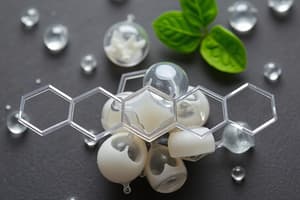Podcast
Questions and Answers
What characterizes a saturated fatty acid?
What characterizes a saturated fatty acid?
- Has a carboxyl group (-COOH) at one end.
- Has a branched-chain structure.
- Contains one or more double bonds.
- Does not contain any double bonds. (correct)
Which statement about polyunsaturated fatty acids (PUFAs) is true?
Which statement about polyunsaturated fatty acids (PUFAs) is true?
- PUFAs contain only one double bond.
- Each double bond is separated by an ester group.
- PUFAs can be classified into categories such as ω-3 and ω-6. (correct)
- PUFAs are classified by the position of the first double bond from the carbonyl group.
What role does linolenic acid (18:3) play in relation to ω-3 fatty acids?
What role does linolenic acid (18:3) play in relation to ω-3 fatty acids?
- It is a nonessential fatty acid in the human diet.
- It has a branched-chain structure.
- It is a saturated fatty acid.
- It serves as a precursor to other ω-3 fatty acids. (correct)
Which of the following fatty acids would be classified as short-chain?
Which of the following fatty acids would be classified as short-chain?
What is the main feature of fatty acids' presence in the bloodstream?
What is the main feature of fatty acids' presence in the bloodstream?
Which of the following fatty acids cannot be synthesized by the body and must be obtained through diet?
Which of the following fatty acids cannot be synthesized by the body and must be obtained through diet?
What type of fatty acids are primarily included in the group of nonessential fatty acids?
What type of fatty acids are primarily included in the group of nonessential fatty acids?
Which essential fatty acid is known as a precursor to eicosanoids and is found in peanut oil?
Which essential fatty acid is known as a precursor to eicosanoids and is found in peanut oil?
What is the primary role of essential fatty acids in cell membranes?
What is the primary role of essential fatty acids in cell membranes?
Which of the following sources is known for being high in ω3 polyunsaturated fatty acids?
Which of the following sources is known for being high in ω3 polyunsaturated fatty acids?
Flashcards
Essential Fatty Acids
Essential Fatty Acids
Fatty acids that the body cannot produce and must get from food.
Nonessential Fatty Acids
Nonessential Fatty Acids
Fatty acids the body can synthesize from other substances.
Polyunsaturated Fatty Acids
Polyunsaturated Fatty Acids
Fatty acids with more than one double bond.
Linoleic Acid
Linoleic Acid
Signup and view all the flashcards
Sources of Essential Fatty Acids
Sources of Essential Fatty Acids
Signup and view all the flashcards
Lipid Definition
Lipid Definition
Signup and view all the flashcards
Fatty Acid Structure
Fatty Acid Structure
Signup and view all the flashcards
Polyunsaturated Fatty Acid (PUFA)
Polyunsaturated Fatty Acid (PUFA)
Signup and view all the flashcards
Essential Fatty Acid
Essential Fatty Acid
Signup and view all the flashcards
ω-3 PUFA
ω-3 PUFA
Signup and view all the flashcards
Study Notes
Lipids
- Lipids are compounds that are relatively insoluble in water, but freely soluble in non-polar organic solvents (e.g., benzene, chloroform, ether, hot alcohol, acetone).
- Fatty acids have the chemical formula RCOOH.
- Fatty acids are water-insoluble "long-chain hydrocarbons".
- They are mostly monocarboxylic (i.e., having one carboxyl group at the end of the chain) (—COOH).
- Fatty acids are mostly aliphatic (i.e., not branched).
- A few branched-chain fatty acids are present in animals and plants.
- Fatty acids can be saturated (no double bonds) or unsaturated (containing one or more double bond).
- Essential fatty acids cannot be synthesized by the body.
- Nonessential fatty acids can be synthesized in the body.
- Fatty acids occur mostly as esters in natural fats and oils in the plasma carried on PP.
- Short-chain F.A. : less than 10 C
- Long-chain F.A. : more than 10 C.
Polyunsaturated Fatty Acids (PUFA)
- Definition: They are fatty acids containing more than one double bond.
- In polyunsaturated F.A., each 2 double bonds are separated by a methylene group (-CH2-).
- Classification: PUFAs are classified according to the position of the first double bond in relation to the ω carbon.
- ω3 PUFAs have the 1st double bond at carbon 3 in relation to ω carbon.
- Examples: Linolenic acid (18:3) and Cervenic acid (22:6).
Studying That Suits You
Use AI to generate personalized quizzes and flashcards to suit your learning preferences.




